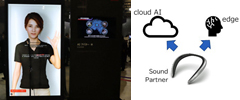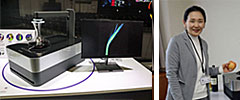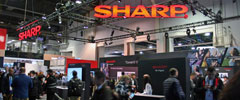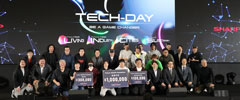Improves operability with “Click Display” near-future device ②
April 19, 2023

* Car navigation and audio can be displayed at the same time
In the previous issue, we introduced the features of “Click Display” and the background of its development. In this issue, we will introduce the mechanism of pressure detection and responses of visitors to our exhibit at CES2023, a technology trade show held in the U.S. Continuing from the previous interview, we spoke with Yuki and Yamamoto of Sharp Display Technology Corporation (SDTC).

– Please briefly introduce the mechanism and principle of the pressure sensor.
(Yamamoto)Capacitive touch sensors detect weak electrical changes caused by the touch of a finger or other objects. Pressure sensors, on the other hand, use the shrinking of the pressure-sensing material (change in distance) when “pressed” to detect the pressure being pressed. For example, a weak push can be used to display the screen, and a strong push can be used to enlarge the screen. The “Click Display” has a pressure sensing material placed on the same layer as the capacitive touch sensor.

– The “Click Display,” which has no buttons but functions like buttons, is truly a display of the near future. Wasn’t it difficult to develop?
(Yamamoto)“Click Display” was developed mainly for in-vehicle applications. Automobile manufacturers require a cover glass thicker than 1 mm for safety measures, but the thicker the glass, the harder it is to transmit pressure to the sensor. In addition, the sensor must operate in harsh environments, from extreme cold in the winter to the hot temperature in the summer. We went through a trial-and-error process to find a combination of a unique sensor pattern and pressure-sensing material that would allow the sensor to easily detect pressure and withstand environmental changes, while keeping an eye on the cost.
Other efforts were made to improve the algorithm to reduce noise and extract pressure-only signals (clean waveforms) from the detected signals.
(Yuki) We decided that for in-vehicle use, it would be better from a safety standpoint if the input point could be recognized without looking at the screen. With the cooperation of the design department, we added a cover with an uneven surface and aimed to create a design that would make the user recognize the position of the button. However, even a good design can be difficult to see due to unevenness. We sought a shape that would have minimal impact on the display through optical analysis. At the same time, we considered the operability by touch, and repeatedly considered how to reproduce the tactile sensation of “there is a button there”.

– What responses did hear from exhibiting at Finetech Japan and CES2023?
(Yuki) We heard directly from customers who had tried the products at the hands-on corner, saying “I want this! or “This is interesting because it expands the possibilities of touch UI (user interface)”. We also received requests from automobile manufacturers who are actually developing UIs to lend our prototypes for their study to prevent operation errors.


– Finally, what are your future developments and aspirations?
(Yuki) The interest we have received from many customers has given us confidence. We aim to commercialize the product as soon as possible to meet their expectations.
As a next step, we are considering whether it is possible to do the same thing on a flat surface without an uneven surface cover. We are considering whether we can reproduce the tactile feel of the buttons on a flat display, while maintaining the comfort and operability of a physical keyboard by devising haptics vibrations. This would result in a visually clean UI.
We believe that “Click Display” can be applied to many other things besides automobiles, such as washing machines, refrigerators and other kitchen appliances, remote controls, etc. Internally, we would like to develop new products in cooperation with the people in charge of each product planning and development. We would also like to actively make proposals outside the company and hope that “Click Display” will be adopted.
– Thank you very much.
When I actually operated it, I did indeed experience a button-like clicking sensation. I felt that replacing operation areas with physical buttons and touch panels with “clip displays” would result in a cleaner design and a very simple and people-friendly UI. The “Clip Display” can flexibly change the display and contents of the screen according to the application, and is expected to be useful in the center console of automobiles and also in various applications other than in-vehicle use.
(Public Relations H)
<Related Sites>
News Release: Sharp to Take Part in CES 2023, Major US Tech Event
SHARP Blog: A click feeling as if you were pressing a button even if there is no button! What is the “Click Display”, a device of the near future? ①
米国のテクノロジー見本市「CES 2023」に出展しました (Japan only)
Award: 第28回ディスプレイ国際ワークショップ<IDW ’21>において「Sharp Force Touch」がBest Paper Awardを受賞(Japan only)




